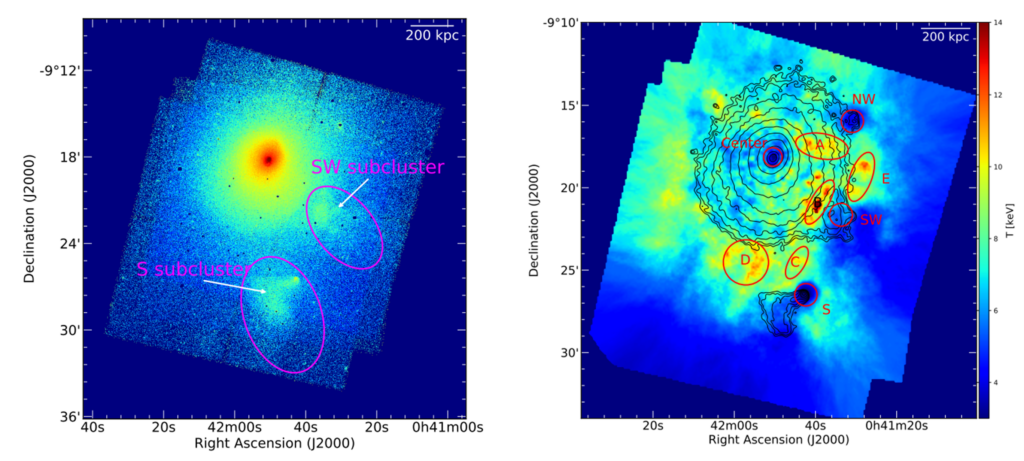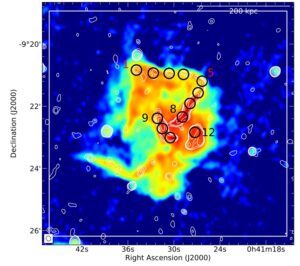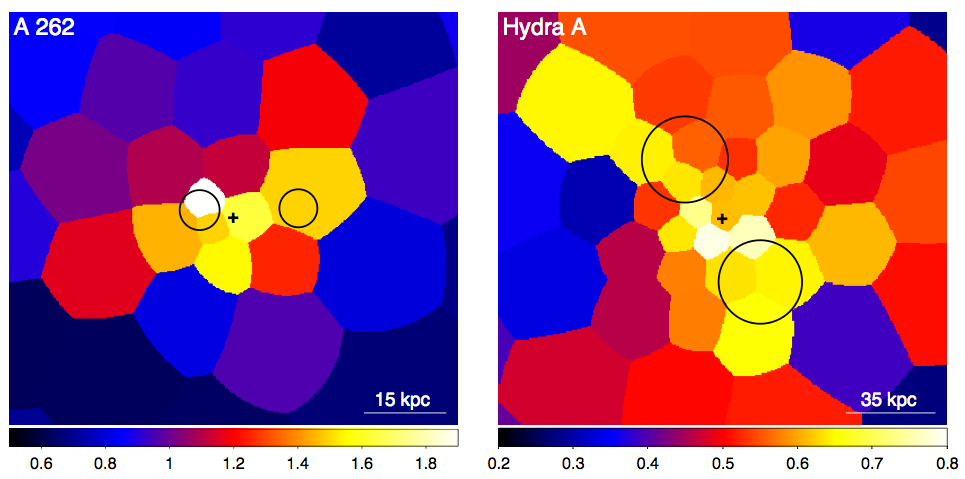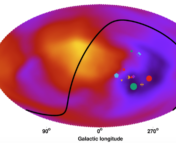Title: On the Origin of Diffuse Radio Emission in Abell 85 – Insights from new GMRT Observations
Authors: Majidul Rahaman, Ramij Raja, Abhirup Datta, Jack O Burns, and David Rapetti
First Author’s Institution: Department of Astronomy, Astrophysics and Space Engineering, Indian Institute Of Technology Indore, Indore, India
Status: Accepted for publication in the Monthly Notices of the Royal Astronomical Society [closed access]
Deep in the reaches of space, a phoenix might be coming back to life! Galaxy clusters are some of the largest and most turbulent objects in the universe, containing many hundreds of galaxies bound together by gravity. These galaxies are surrounded by a hot, turbulent plasma- so hot, in fact, that we detect X-rays from its thermal emission. The plasma has had time to expand and cool, but interactions between galaxies in the cluster or with other objects can create shocks of supersonic material in the plasma. These shocks compress the plasma, reactivating strong magnetic fields and re-accelerating electrons in those regions, causing them to emit synchrotron radiation in the form of radio waves. We call these regions of reactivated radio emission radio phoenixes, and they can show us the distribution and properties of electrons which have been in the cluster, mostly unchanged, for an extremely long time.
This paper presents new observations of Abell 85, a galaxy cluster containing a galaxy with one of the largest black holes we’ve ever measured! In addition to looking at archival X-ray data from the Chandra X-ray Observatory, the authors of this paper present a new high-resolution map of the cluster in radio waves, taken with the Giant Metrewave Radio Telescope (GMRT) in India. This new map shows the radio phoenix in Abell 85 to have a complex structure made of long, thin filaments (see Figure 2 for a spoiler), and the spectrum (or brightness as a function of observing frequency) of the emission is very steep. Previous studies and simulations of radio phoenixes have shown steep spectra and a complex, filamentary structure, so these properties make this radio phoenix fairly standard. What’s more, using the X-ray data to make a temperature map of the cluster allowed the authors to look for these turbulent shocks, and they found one lining up very well with the radio phoenix!
The left panel of Figure 1 shows the X-ray brightness map of the galaxy cluster, with the red spot corresponding to the bright center of the cluster, and two subclusters south and southwest of the main cluster. The right panel shows the temperature map, which is made from the brightness map after accounting for the absorption of the interstellar medium, the spectral properties of the plasma, and differentiating between the source and the background objects in the image. This temperature map shows that the cluster actually has a cool center, with hot spots indicated with red ellipses. These two panels map the same region- so the hot regions B-E on the right line up very well with the edges of the two subclusters in the left panel, adding evidence to the idea that these smaller structures are actively merging into the main cluster, mixing up the electrons and heating up the plasma to reactivate this radio phoenix!


But the star of the show is the new map of the radio emission from the galaxy cluster, taken by the GMRT (Figure 2)! This map is the highest definition radio image of the region ever taken, and revealed the filamentary shape of the radio phoenix. Radio relics which are not phoenixes tend to display more ‘blobby’ and less filamentary structure, so this stream of brighter emission helps solidify that this is indeed a phoenix getting reactivated.
Using the X-ray and radio maps in conjunction, the authors created a program which would search these maps for shocks. By looking for temperature discontinuities between pixels in the X-ray map, and changes in the spectral index of the radio emission, they could translate these into a calculation of the Mach number at that point- a measure of how fast the shock is traveling through the medium, with a Mach number greater than 1 meaning the shock is moving faster than the speed of sound!
The authors found convincing evidence of a shock perfectly co-located with the radio phoenix and the southwest subcluster (see Figure 3). The Mach numbers are low enough, albeit with some uncertainty, that we would expect them to be caused by merger shocks– and since that shock is located at the same region as the subcluster, the authors conclude that the most likely scenario is that the subcluster is merging into the main cluster, creating a shock that reactivates the radio emission in the region, causing the radio phoenix to rise from the ashes.

Despite all these signs that seem to point directly to this object being a radio phoenix, the authors point out a few inconsistencies and a possible alternative explanation. While there haven’t been many well-documented radio phoenixes, this one is much larger and farther from the center of the cluster than average. A competing theory of radio phoenixes is that if gas gets sloshed around in the galaxy cluster, it could push radio-emitting electrons around and shape them into a filamentary structure which looks like a phoenix without actually being one. A large gas sloshing arm in A85 has been identified in previous studies, with the radio phoenix right at the end of it; on top of that, these new radio images revealed two radio-emitting galaxies with long tails within the radio phoenix. There is no conclusive evidence either way, but it’s plausible that these energetic tails could be injecting radio-emitting electrons into the galaxy cluster, where they get sloshed around by that gas sloshing arm to form an imposter radio phoenix. Whatever ends up being the case, the astronomical community will be keeping its eyes peeled for any more cosmic birds flapping their wings!
Astrobite edited by Jessie Thwaites and Roan Haggar
Featured image credit: this paper, and Niki Vandermosten




